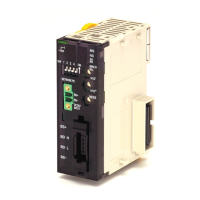5-31
5 Operation
CJ-series PROFIBUS Master Unit Operation Manual for NJ-series CPU Unit (W509)
5-5 I/O Communication Characteristics
5
5-5-2 Mapping I/O Data
Enable/Disable Auto Addressing
The Auto Addressing feature can be disabled in the CJ1W-PRM21 Master DTM. Perform the follow-
ing sequence to control Auto Addressing.
1
Open the CJ1W-PRM21 Master DTM - Configuration User Interface.
2
Select the Master Setup tab.
3
Enable/Disable Auto Addressing by selecting/deselecting the Auto Addressing checkbox in
the Support box.
4
When Auto Addressing is being enabled, a warning message is displayed, informing the user of
the effects of enabling Auto Addressing.
Precautions for Correct UsePrecautions for Correct Use
Enabling Auto Addressing has the immediate effect of re-allocating I/O modules of an existing
configuration, within each Input/Output area. The I/O modules are re-mapped according to the
algorithm described above.
Note Disabling Auto Addressing has no immediate effect on an existing I/O mapping.
I/O Mapping Without Auto Addressing
A disabled Auto Addressing feature has the following effects on I/O mapping:
• When adding new slave devices or new I/O modules to an existing slave configuration, the I/O
modules will be mapped to the first I/O areas, but the modules will be appended to the existing I/O
mapping.
• When deleting a slave device from the network configuration, or deleting I/O modules from a
slave device, the deleted I/O modules will leave gaps behind in the already existing I/O mapping.
If after deleting an I/O module a slave device still has more than one module configured and these
modules are not in the same place, the DTM will attempt to remap them together.
• Changing the address of a slave device, of which already an I/O mapping exists, has no effect on
the existing mapping.
• Selecting an additional I/O module for a slave device, in the presence of already allocated I/O
modules, will cause a complete re-map of all existing modules if the total I/O does not fit within the
space it is already occupying. The modules are re-mapped to the next available location in the
area, leaving behind a gap in the existing I/O mapping. Subsequent I/O modules of other slave
device will remain mapped as before the module addition.
• When moving an I/O module from one area to another, they can be located anywhere with in the
target area. They are not re-mapped to the start of that.
• When moving an I/O module from one area to another, the module leaves behind a gap in the I/O
mapping of the first area.
Note 1 Gaps in the I/O mapping still contribute to the total size of an area, although they do not
contain valuable data. They therefore decrease the total I/O capacity of the CJ1W-PRM21
PROFIBUS Master Unit, and unnecessarily occupy CPU memory.
2 In the I/O data exchange with the CPU, these gaps will contain zeros.
The figure below illustrates the effects of re-allocating I/O modules, when Auto Addressing has been
disabled.

